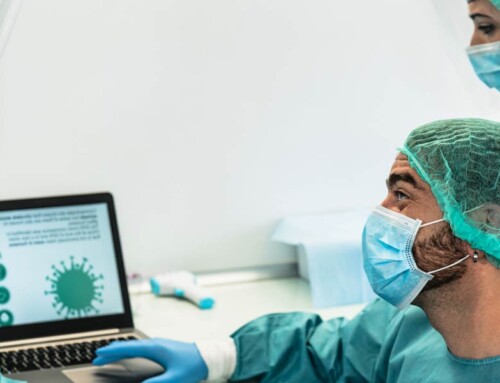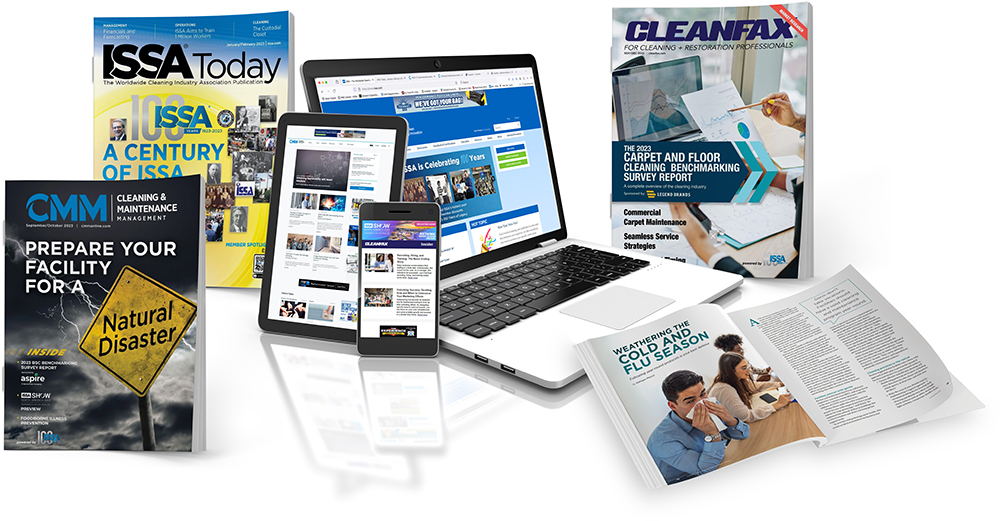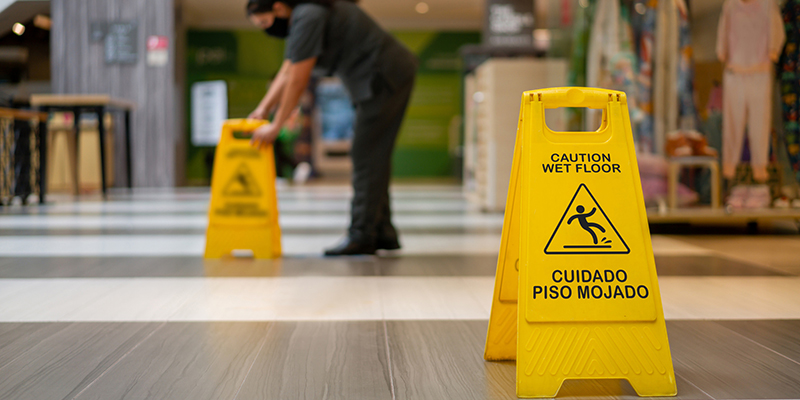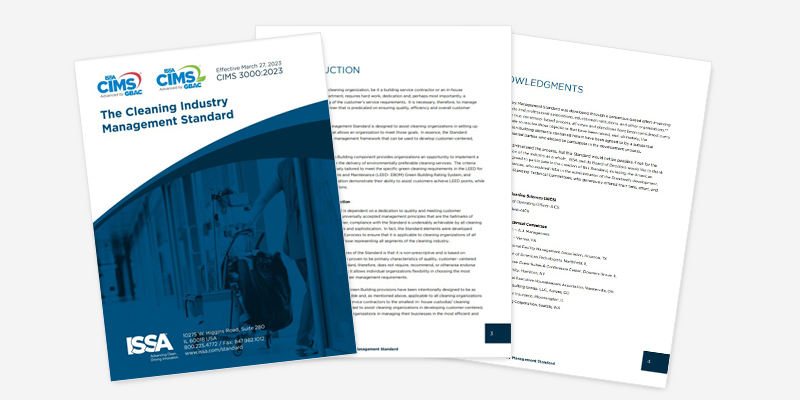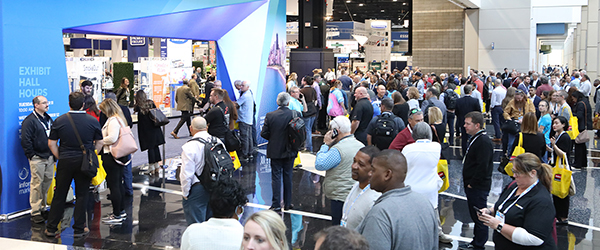Confronting C. diff With the Right Products and Techniques
![Cdiff_bathroom_052025[19]](https://www.issa.com/wp-content/uploads/2025/05/Cdiff_bathroom_05202519.png)
C. diff, short for Clostridioides difficile, is a bacterium that can disrupt the balance of bacteria in the gut, cause infections in the colon, and lead to symptoms like diarrhea, abdominal pain, fever, and even life-threatening complications.
Cleaning to prevent the spread of C. diff requires thorough disinfection, especially in areas where an infected person has been. It can be challenging because the bacteria produce spores that are highly resistant to many common disinfectants and can survive on surfaces for months. But it is manageable with the right products and techniques. Effective cleaning requires bleach-based disinfectants or other hospital-grade cleaners specifically designed to kill C. diff spores.
Two experts on the subject from PDI Healthcare, Alice Brewer, MPH, CIC, CPHQ, FAPIC, head of clinical affairs, and Julie Nakos, director of national accounts for environmental services (EVS) and janitorial and sanitation (jansan), agreed to share their insights with us. Here are the questions we asked them.
- From your perspective, how significant is the current threat of C. diff in health care settings, and what does the latest data tell us about infection rates and outcomes?
- diff remains one of the most persistent and deadly healthcare-associated infections (HAIs). According to recent CDC data, C. diff is one of the most common and persistent HAIs, causing nearly 500,000 infections in the United States annually, with more than 20,000 deaths.
Unfortunately, C. diff has a high recurrence rate, with about one in six patients getting repeat infections two to eight weeks after the initial infection. Though infection rates declined slightly during the pandemic, they are rebounding in some settings as focus shifts. Outcomes can include severe diarrhea, colitis, sepsis, and increased mortality, particularly in elderly or immunocompromised patients. People over the age of 65 are particularly vulnerable, and one in 11 dies within a month of diagnosis.
This data underscores that C. diff is resurging in healthcare settings, driving hospital stays and significantly impacting the economy. It highlights the urgent need for sustained infection‑control measures, judicious antibiotic use, and rigorous preventive strategies.
- What are the most common modes of C. diff transmission in a facility, and where do environmental cleaning practices often fall short?
Transmission of C. diff in healthcare settings occurs primarily via the fecal–oral route, with spores spreading through:
- Contaminated surfaces and equipment, including bed rails, toilets, tables, call buttons, bedside commodes, and medical equipment, and even doorknobs.
- Healthcare workers’ hands and gloves: Even after glove removal, spores can linger on skin if hand hygiene is incomplete.
The most significant gaps in cleaning include:
- Inadequate disinfection of high-touch surfaces: Routine cleaning often overlooks less obvious spots—under bed rails, behind call‑button panels, the undersides of over‑bed tables, and privacy curtains—allowing spores to persist and re‑contaminate hands and equipment.
- Improper dwell/contact time: Many disinfectants require several minutes of surface wetness to kill C. diff spores. Wipes and sprays are often wiped away too quickly or not reapplied as needed, reducing their sporicidal efficacy.
- Using products ineffective against spores: EPA‑registered solutions or sporicidal products are required for thorough disinfection.
- Inadequate staff training: Without regular checks and thorough training, staff may be unaware of proper dilutions, wipe usage, or cleaning sequence.
- What specific protocols should cleaning professionals follow to break the chain of transmission for C. diff, especially in patient rooms and high-touch areas?
Cleaning professionals are on the front lines of preventing C. diff transmission. To break the chain of infection, particularly in patient rooms and other high‑touch areas, they should adhere to the following protocols:
- Practice proper hand hygiene.
- Wear appropriate personal protective equipment (PPE).
- Use of EPA-registered sporicidal disinfectants (found on EPA’s List K).
- Maintain strict adherence to manufacturer-specified contact times.
- Disinfect from clean to dirty surfaces to avoid cross‑contamination.
- Target all high-touch surfaces (e.g., bed rails, call buttons, toilets).
- Perform thorough terminal cleaning post-discharge.
- Use a layered approach with an ultraviolet C (UVC) device.
- Ensure that laundry is handled accordingly.
Consistent execution of these steps—combined with routine training, monitoring, and performance audits—creates a robust environmental hygiene program that reduces the risk of C. diff exposure for patients, staff, and visitors.
- How important is formulation selection when it comes to surface disinfectants? Are there particular chemistries or contact times that are most effective against C. diff spores?
Formulation selection is essential when choosing surface disinfectants for C. diff. The C. diff spores can survive on inanimate surfaces for up to five months and resist most routine hospital disinfectants, so only sporicidal disinfectant agents will reliably achieve inactivation. Facilities should refer to the EPA’s List K—a roster of over 90 products approved specifically for C. diff. Still, not all List K formulations are equally practical in a healthcare environment.
In a healthcare setting, using an intermediate‑level disinfectant that combines broad‑spectrum germicidal coverage (including spores), surface compatibility, and ease of daily use is best. By selecting formulations from EPA’s List K that balance rapid sporicidal efficacy with gentle handling characteristics and strict adherence to manufacturer‑specified contact times, healthcare facilities can break the chain of C. diff transmission.
- Can you speak about the role of proper hand hygiene in controlling the spread of C. diff, especially considering the organism’s spore-forming nature?
According to the World Health Organization, hands are the most common way of transmitting healthcare‑associated pathogens. Although alcohol hand gels are commonplace in healthcare settings and effective against many organisms, they are ineffective against C. diff spores. To remove contamination, hands must be cleaned with soap and water for 40–60 seconds.
Hands that have not been adequately cleaned can spread C. diff spores to other surfaces and people throughout the facility. Ensuring easy access to dedicated hand‑washing stations and implementing routine compliance monitoring with ongoing education and feedback have significantly boosted proper hand‑hygiene practices.
- What are the key differences between routine and terminal cleaning when dealing with C. diff cases, and how should cleaning teams be trained to handle each?
Routine cleaning in rooms with active C. diff patients takes place while the space remains occupied, so environmental services staff concentrate on disinfecting high‑touch surfaces (bed rails, call buttons, light switches) and restrooms. Teams must use EPA‑registered sporicidal agents with proper dwell times, follow a “clean‑to‑dirty” sequence, change gloves and gowns between patient rooms, and perform hand hygiene to prevent cross‑contamination.
Terminal cleaning begins once a patient is discharged and involves a comprehensive, top‑to‑bottom disinfection of every surface—including bed frames, mattresses, curtains, and all movable equipment—often augmented by UVC.
Training and education are essential and should include initial onboarding and ongoing instruction, with hands‑on demonstrations of cleaning techniques, contact times, and PPE protocols. Regular competency checks and feedback help verify compliance and pinpoint gaps, followed by periodic refresher courses to reinforce best practices.
- How effective is UVC disinfection technology as an adjunct to manual cleaning, and what do facilities need to understand about when and how to deploy it?
UVC is very effective as an adjunct but should not replace a complete manual cleaning and disinfecting process. It adds an extra layer of assurance, especially in patient discharge or outbreak scenarios.
Studies have demonstrated the efficacy of UVC against C. diff. It has been shown that by using UVC in high-risk rooms previously occupied by patients with C. diff or other multidrug-resistant organisms (MDROs), the hospital-wide risk of C. diff can be reduced. Facilities can be strategic in deploying UVC devices and still benefit from reducing the risk of transmission. To maximize effectiveness, UVC should always follow thorough manual cleaning, as organic material can block the light and limit disinfection. Training staff in safe operation and room setup is also essential to ensure the surface area receives adequate exposure.
- How can infection preventionists and EVS leaders collaborate more effectively to ensure consistent, measurable disinfection and infection control outcomes?
A strong partnership between infection preventionists (IPs) and environmental services (EVS) leaders is key to reducing healthcare-associated infections (HAIs) and improving disinfection outcomes. While their roles differ, both share responsibility for ensuring clean, safe environments. Regular communication—through joint rounds or quick weekly check-ins—helps align goals, identify challenges early, and reinforce accountability. These touchpoints also build trust and create a more coordinated approach to infection prevention.
Collaboration is further strengthened through joint training and shared feedback. When IPs and EVS leaders learn together, they can align on the latest best practices and co-develop practical staff training. Leveraging their unique expertise—IPs in epidemiology and EVS leaders in practical cleaning execution—results in more thorough, targeted protocols. Together, they can gather staff input, improve implementation, and demonstrate a united commitment to infection control that supports safer outcomes for both patients and staff. For more information, visit: issa.com/articles/evs-directors-and-ips.
- Are there any promising innovations or recent research findings that point to better strategies for controlling C. diff in healthcare environments?
Recent infection control innovations offer more practical and sustainable ways to manage C. diff in healthcare settings. Traditionally, facilities have relied on a two-product approach: a standard disinfectant for routine cleaning and a bleach-based sporicidal for terminal cleaning or known C. diff cases. While effective at killing spores, bleach products can damage surfaces and equipment with frequent use, leading to discoloration, deterioration, and ultimately, greater infection control challenges. This dual-approach system can also lead to confusion among staff, increasing the risk of misuse or inconsistent application.
To address these issues, some facilities are turning to ready-to-use (RTU) sporicidal disinfectants that are non-bleach based and safe for daily use. These newer formulations simplify protocols by reducing the need for multiple products, lowering the risk of surface damage, and improving staff compliance.
In addition, a recent study found that many hospitals using automated disinfectant dispensers had at least one malfunctioning unit—some releasing no disinfectant at all or dispensing it at the wrong concentration. These issues highlight the risks of relying on complex, multi-step systems. Ready-to-use disinfectant wipes offer a better, simpler alternative. They are pre-mixed and pre-measured, combined to clean and disinfect in a single step. By eliminating the need for dispensers, mixing, and multiple products, wipes help streamline workflows and reduce the chance of costly mistakes.
These advancements are helping facilities streamline disinfection processes while enhancing their ability to prevent C. diff transmission.
In conclusion, preventing the spread of C. diff in healthcare settings is an ongoing challenge, but it is manageable with the proper protocols and strategies. From utilizing EPA-approved sporicidal disinfectants and adhering to appropriate hand hygiene practices to ensuring comprehensive cleaning training and leveraging technologies like UVC disinfection, healthcare facilities can reduce infection risk and safeguard patients and staff.
The collaboration between IPs and EVS leaders is vital for ensuring consistent, effective outcomes. As innovations such as non-bleach, ready-to-use disinfectants continue to emerge, the healthcare industry is finding ways to improve its disinfection efforts and address the complexities of controlling C. diff. By staying vigilant and embracing these advancements, healthcare settings can more effectively combat this persistent and deadly infection.
 Julie Nakos leads PDI Healthcare’s EVS distribution channel sales and serves as the primary liaison between PDI and its network distribution partners. She drives growth by implementing cohesive sales, marketing, and specialized programs designed to increase revenue and improve operational efficiency. Julie works cross-functionally with sales, marketing, and R&D to expand business opportunities and deliver strategic results.
Julie Nakos leads PDI Healthcare’s EVS distribution channel sales and serves as the primary liaison between PDI and its network distribution partners. She drives growth by implementing cohesive sales, marketing, and specialized programs designed to increase revenue and improve operational efficiency. Julie works cross-functionally with sales, marketing, and R&D to expand business opportunities and deliver strategic results.
 Alice Brewer leads Clinical Affairs at PDI, where she drives clinical strategy, supports commercialization, and fosters partnerships with industry and government organizations. With over 15 years of experience as an epidemiologist in both pharma and healthcare, she has led teams in regulatory affairs, surveillance, data analysis, and clinical research. Alice is certified in Infection Control and Healthcare Quality, holds degrees in Molecular Biology and Public Health, and is currently pursuing a doctorate in Health Sciences.
Alice Brewer leads Clinical Affairs at PDI, where she drives clinical strategy, supports commercialization, and fosters partnerships with industry and government organizations. With over 15 years of experience as an epidemiologist in both pharma and healthcare, she has led teams in regulatory affairs, surveillance, data analysis, and clinical research. Alice is certified in Infection Control and Healthcare Quality, holds degrees in Molecular Biology and Public Health, and is currently pursuing a doctorate in Health Sciences.

